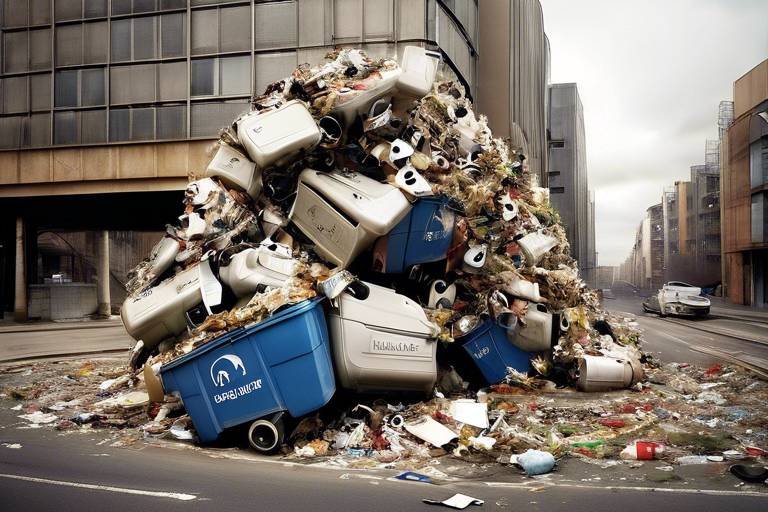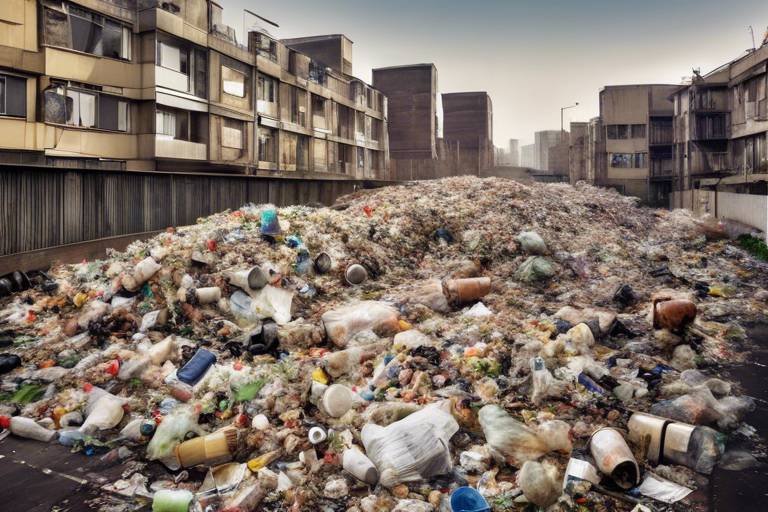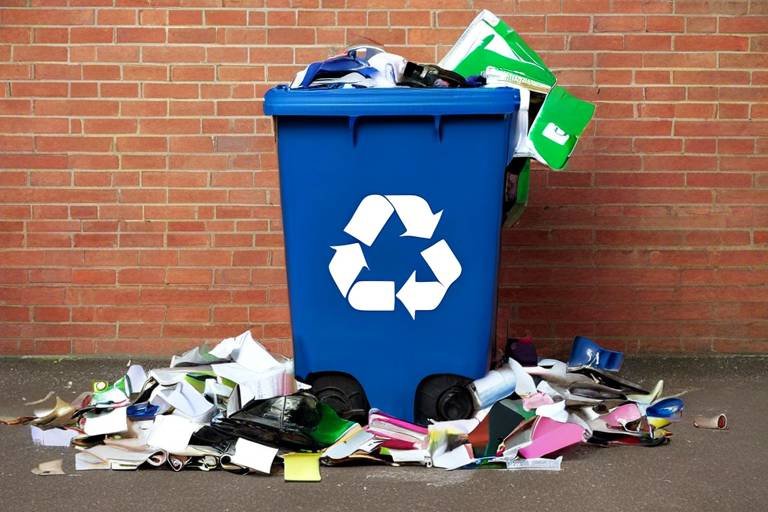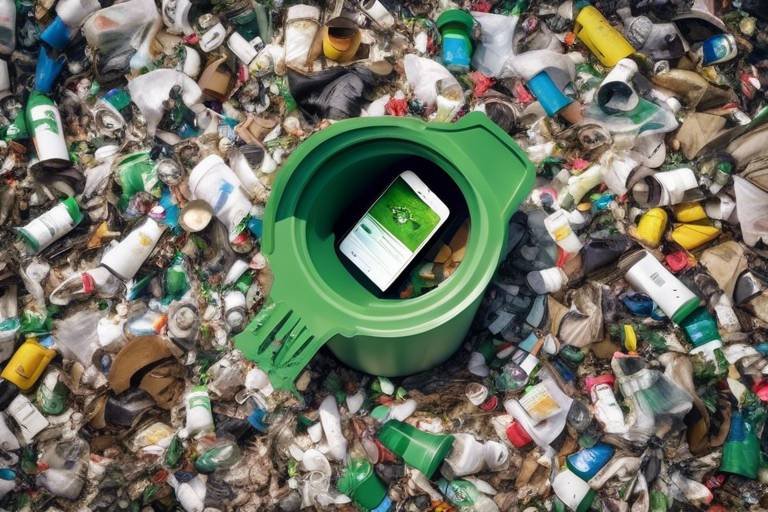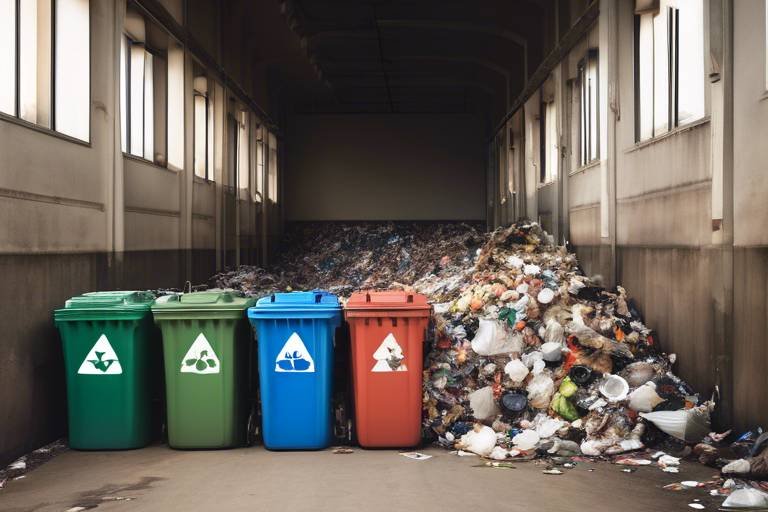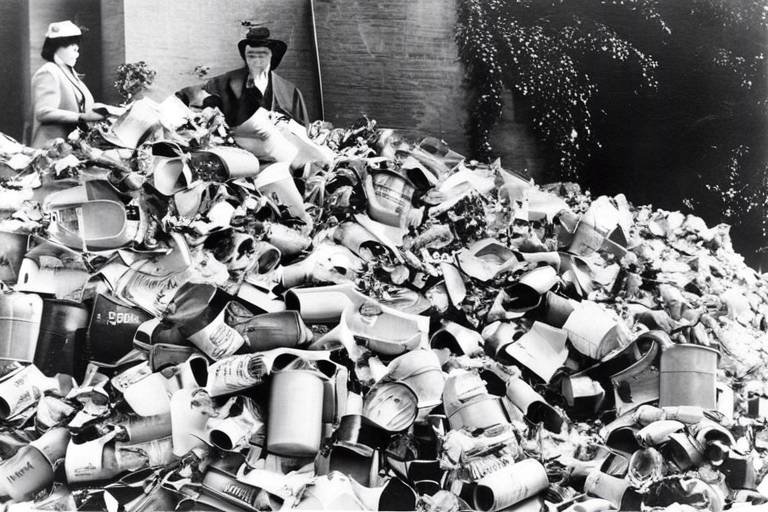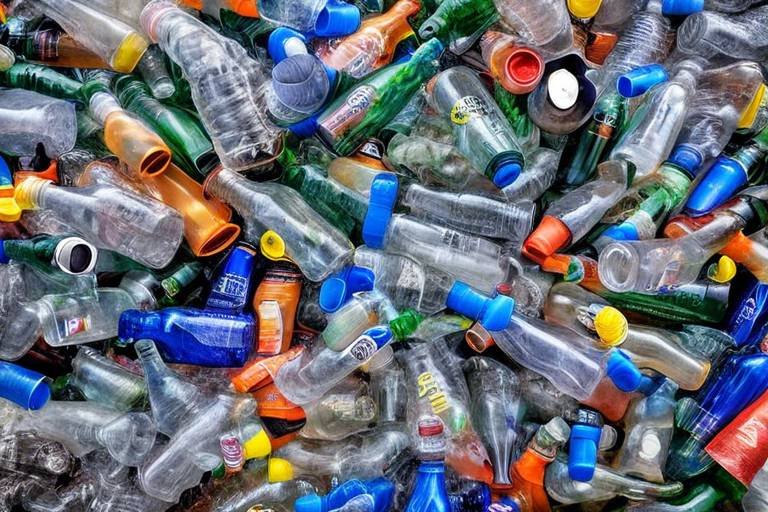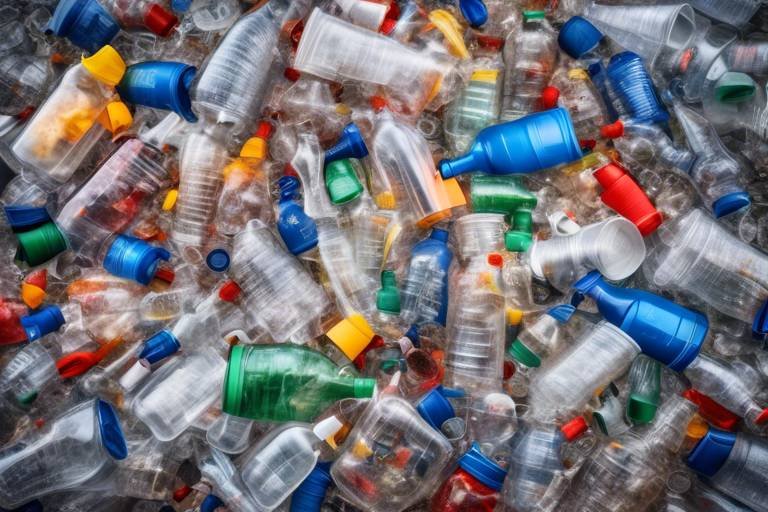The Link Between Recycling and Energy Savings
In a world where resources seem to dwindle every day, the concept of recycling has emerged as a beacon of hope. It's not just about tossing your plastic bottles into a blue bin; it's about embracing a lifestyle that prioritizes sustainability and energy conservation. Have you ever stopped to think about how much energy is saved when we recycle? The truth is, recycling is a powerful tool in our fight against resource depletion and environmental degradation. By understanding the intricate relationship between recycling and energy savings, we can all play a part in fostering a more sustainable future.
Recycling is more than a trend; it's a necessity. As we continue to consume at an alarming rate, the need to conserve energy becomes increasingly critical. Each time we recycle, we are not just reducing waste; we are also conserving energy that would otherwise be used to produce new materials. This energy conservation is vital in today's society, where energy resources are limited and the impact of climate change is becoming more evident. So, how does recycling actually save energy? Let's dive deeper into the processes involved and the significant benefits that come along with them.
Consider this: recycling one ton of paper can save enough energy to power an average home for six months! This astounding fact highlights just how impactful our recycling efforts can be. When we recycle, we are not only reducing the amount of waste that ends up in landfills but also cutting down on the energy required to produce new products from raw materials. The ripple effect of these actions can lead to a more sustainable future for generations to come.
To truly appreciate the link between recycling and energy savings, we must examine the processes involved in recycling various materials. From metals to plastics, each material has its unique recycling process that contributes to energy conservation. For instance, recycling metals like aluminum and steel requires significantly less energy compared to mining and processing new metals. This not only conserves energy but also reduces greenhouse gas emissions, making recycling an essential practice for environmental health.
In summary, the link between recycling and energy savings is clear. By choosing to recycle, we are taking a stand against wastefulness and contributing to a more sustainable world. As we explore the different facets of recycling, we will uncover the specific energy savings associated with various materials and the broader environmental benefits that come from embracing a recycling lifestyle.
- Why is recycling important for energy savings?
Recycling reduces the need for new raw materials, which in turn decreases the energy required for extraction, processing, and manufacturing. - What materials can be recycled to save energy?
Common materials include aluminum, steel, glass, and plastics. Each has its own energy-saving benefits when recycled. - How much energy can recycling save?
Recycling can save a significant amount of energy; for example, recycling aluminum saves up to 95% of the energy required to create new aluminum from raw materials. - What are the environmental benefits of recycling?
In addition to saving energy, recycling reduces landfill waste, conserves natural resources, and lowers greenhouse gas emissions.

The Importance of Recycling
Recycling is not just a trendy buzzword; it’s a vital practice that plays a crucial role in waste management and resource conservation. Think of recycling as a superhero for our planet, swooping in to save the day by reducing the amount of waste we produce and conserving precious resources. When we recycle, we’re not only giving materials a second life but also significantly minimizing our carbon footprint and energy consumption. This is something every individual and community should appreciate, as our collective efforts can lead to monumental changes in the environment.
So, why is recycling so important? First and foremost, it helps to conserve natural resources. Every time we recycle paper, plastic, or metal, we’re reducing the need to extract and process new raw materials. For example, recycling just one ton of paper can save 17 trees, 7,000 gallons of water, and enough electricity to power an average home for six months! Isn’t that astounding? These statistics highlight the significant impact of recycling on our natural resources and energy conservation.
Moreover, recycling fosters a sense of community responsibility. When individuals and organizations engage in recycling initiatives, they create a culture of sustainability that inspires others to follow suit. It’s like a chain reaction: one person’s commitment to recycling can encourage their friends, family, and even their entire neighborhood to join in. This collective action can lead to substantial reductions in waste and energy use, amplifying the benefits of recycling.
Additionally, recycling plays a pivotal role in economic sustainability. The recycling industry creates jobs and stimulates the economy by turning waste into valuable resources. According to the Environmental Protection Agency (EPA), recycling and reuse activities in the United States accounted for over 1.1 million jobs and generated $236 billion in revenue. This demonstrates that recycling is not only good for the environment but also for our economy.
In summary, the importance of recycling cannot be overstated. It conserves natural resources, reduces energy consumption, fosters community responsibility, and supports economic growth. By embracing recycling as a fundamental practice, we can all contribute to a healthier planet and a sustainable future. So, the next time you toss a bottle or a can into the recycling bin, remember: you’re not just recycling; you’re being part of a much larger movement towards sustainability!

Energy Savings Through Recycling
When we think about recycling, we often picture bins filled with paper, plastic, and metal. But have you ever stopped to consider the **energy savings** that come with recycling? It's like finding a hidden treasure in your backyard; once you dig a little deeper, the benefits start to shine. Recycling is not just about reducing waste; it's a powerful tool in conserving energy that can lead to a healthier planet. In fact, recycling can save up to **75% of the energy** required to produce new products from raw materials. Imagine the impact if every household embraced this practice!
To put this into perspective, let’s look at some specific materials and the energy savings associated with their recycling. For instance, recycling **one ton of paper** can save about **4,100 kilowatts of electricity**, enough to power an average home for **six months**. That’s a significant amount of energy just by sorting your waste! Similarly, recycling metals, plastics, and glass can lead to substantial reductions in energy consumption. Each material has its own story, and the numbers are eye-opening.
| Material | Energy Saved by Recycling (compared to new production) |
|---|---|
| Aluminum | Up to 95% |
| Steel | About 60% |
| Paper | About 40% |
| Plastic | Up to 70% |
As you can see from the table, the energy savings from recycling are staggering. It’s almost like a **magic trick** where you can produce new materials with significantly less energy. This not only helps in conserving our precious resources but also reduces the **carbon footprint** associated with manufacturing processes. With each item we recycle, we contribute to a larger movement towards sustainability, and the ripple effect can lead to substantial changes in energy consumption patterns globally.
Moreover, recycling reduces the need for **landfill space**, which is another significant aspect of energy savings. Landfills require energy for their operation, including transportation of waste and management of the site. By recycling, we are not only saving energy in the production phase but also in the waste management phase. It’s a win-win situation!
So, the next time you toss that soda can into the recycling bin, remember that you’re not just being responsible; you’re playing a vital role in conserving energy and protecting our environment. It’s a small action with a **big impact**. By understanding the energy savings associated with recycling, we can all make more informed decisions that contribute to a **sustainable future**.

Metals Recycling
Recycling metals is an incredibly efficient process that not only conserves energy but also reduces the environmental impact associated with mining and manufacturing new materials. When we talk about recycling metals, we often think of common materials like aluminum and steel, which are prevalent in our daily lives. But did you know that recycling these metals can save a staggering amount of energy compared to producing them from raw ores? This is not just a minor benefit; it’s a significant leap toward a more sustainable future. For instance, recycling aluminum saves up to 95% of the energy required to create new aluminum from bauxite ore. This remarkable statistic underscores the importance of recycling in our energy conservation efforts.
So, how does this all work? When we recycle metals, we essentially take scrap metal and melt it down to create new products. This process requires much less energy than extracting and processing raw materials. Let’s break it down a bit:
| Metal Type | Energy Savings (%) | Environmental Impact |
|---|---|---|
| Aluminum | 95% | Reduces mining waste and habitat destruction |
| Steel | 60% | Decreases CO2 emissions and conserves iron ore |
| Copper | 85% | Lessens the need for new mining operations |
As you can see from the table above, the energy savings from recycling metals are substantial. But it’s not just about energy; recycling metals also helps in reducing pollution. When we recycle, we minimize the need for mining, which is often associated with significant environmental degradation. Mining operations can lead to deforestation, soil erosion, and water contamination. By choosing to recycle metals, we are actively participating in a cycle that promotes the health of our planet.
Moreover, recycling metals contributes to the circular economy, where materials are reused and repurposed rather than discarded. This concept is gaining traction as more individuals and businesses recognize the importance of sustainable practices. By recycling metals, we are not only saving energy but also creating jobs in the recycling industry, promoting economic growth while protecting our environment.
In conclusion, metals recycling is a powerful tool in our fight against climate change and resource depletion. It’s a simple yet impactful way for each of us to make a difference. The next time you toss that aluminum can or steel scrap into the recycling bin, remember that you’re contributing to a larger movement aimed at conserving energy and protecting our planet for future generations.
- Why is recycling metals important? Recycling metals reduces energy consumption, conserves natural resources, and minimizes environmental pollution.
- What metals can be recycled? Common metals that can be recycled include aluminum, steel, copper, and brass.
- How can I recycle metals in my community? Check with local waste management services or recycling centers for guidelines on metal recycling.
- What happens to metals after they are recycled? Recycled metals are melted down and reformed into new products, reducing the need for raw material extraction.

Aluminum Recycling Benefits
When it comes to recycling, aluminum stands out as a superstar in energy conservation. Did you know that recycling aluminum can save up to 95% of the energy required to produce new aluminum from raw materials? This staggering figure isn't just a number; it translates into real-world benefits that impact our environment and economy. Imagine if every can you recycled contributed to saving enough energy to power your home for a week! That's the kind of magic aluminum recycling can work.
The process of recycling aluminum is both efficient and effective. It begins with collecting used aluminum products, which are then cleaned and melted down. This melting process requires significantly less energy compared to the energy-intensive process of extracting aluminum from bauxite ore. In fact, producing aluminum from raw materials can consume up to 8 times more energy than recycling it. This means that every time we choose to recycle an aluminum can, we are not just conserving energy, but also reducing the demand for mining and processing new materials.
But the benefits of aluminum recycling extend beyond just energy savings. Let’s take a moment to consider its environmental impact:
- Reduction of landfill waste: Aluminum is infinitely recyclable, meaning it can be recycled over and over without losing quality. This helps divert a significant amount of waste from landfills.
- Decreased greenhouse gas emissions: By recycling aluminum, we can cut down on the greenhouse gases emitted during the production of new aluminum. This is crucial in our fight against climate change.
- Conservation of natural resources: Recycling aluminum reduces the need for mining, which can lead to habitat destruction and other environmental issues.
Moreover, the economic benefits of aluminum recycling are equally compelling. The recycling industry creates jobs and stimulates local economies. In fact, for every job in the aluminum production sector, there are approximately 1.17 jobs in the recycling sector. This means that by supporting aluminum recycling, we are not only saving energy but also boosting our economy and creating sustainable job opportunities.
In conclusion, the benefits of aluminum recycling are undeniable. From significant energy savings and reduced environmental impact to economic growth and job creation, recycling aluminum is a win-win for everyone involved. So, the next time you finish a soda, remember that your simple act of recycling can have a profound impact on our planet's health and future.
Q: How much energy does recycling aluminum save compared to producing new aluminum?
A: Recycling aluminum saves up to 95% of the energy required for producing new aluminum from raw materials.
Q: Can aluminum be recycled indefinitely?
A: Yes! Aluminum can be recycled indefinitely without losing its quality, making it one of the most sustainable materials.
Q: What happens to aluminum cans when they are recycled?
A: Aluminum cans are collected, cleaned, melted down, and then reformed into new aluminum products, ready to be used again.
Q: How does aluminum recycling help reduce greenhouse gas emissions?
A: By recycling aluminum, we reduce the need for energy-intensive production processes, which in turn lowers greenhouse gas emissions associated with manufacturing.

Steel Recycling Advantages
When it comes to recycling, steel is often overlooked, but it deserves the spotlight for its remarkable energy savings and environmental benefits. Did you know that recycling steel uses about 60% less energy than producing new steel from raw materials? This is a game changer in the fight against energy consumption and waste. The process of recycling steel not only conserves energy but also reduces the need for mining, which can be an incredibly destructive practice. By recycling steel, we are essentially giving new life to old materials, making our planet more sustainable.
Let's dive deeper into the energy efficiency of steel recycling. The recycling process begins with collecting scrap steel, which is then cleaned and melted down in a furnace. This is where the magic happens; the energy required to melt recycled steel is significantly lower than that needed to extract and process iron ore. To put it in perspective, consider this: recycling one ton of steel saves enough energy to power a home for almost two months. This is a staggering statistic that highlights just how impactful steel recycling can be.
Moreover, the benefits of steel recycling extend beyond just energy savings. By recycling steel, we also contribute to reducing greenhouse gas emissions. The steel industry is known for its high carbon footprint, but recycling can cut emissions by up to 70%. This is crucial in our battle against climate change, as every ton of recycled steel prevents approximately 1.5 tons of carbon dioxide from being released into the atmosphere.
In addition to energy conservation and emission reductions, steel recycling supports the economy. The recycling industry creates jobs and fosters innovation in sustainable practices. With the growing demand for recycled materials, companies are investing in technologies that improve the efficiency of steel recycling processes. This not only helps our environment but also boosts local economies. The more we recycle, the more we can create a circular economy where materials are reused rather than discarded.
In conclusion, the advantages of steel recycling are multifaceted. From significant energy savings to reduced emissions and economic benefits, the case for recycling steel is compelling. It’s a simple yet powerful action that we can all take part in. So, the next time you come across a steel product, remember that recycling it can contribute to a healthier planet. Let's make a conscious effort to recycle our steel and encourage others to do the same!
- What types of steel can be recycled? Most types of steel, including stainless steel, carbon steel, and alloy steel, can be recycled. Items like appliances, cars, and construction materials are common sources of recyclable steel.
- How is recycled steel used? Recycled steel is used in a variety of applications, including construction, automotive manufacturing, and home appliances. It can be transformed into new products, reducing the need for virgin materials.
- Is recycling steel cost-effective? Yes, recycling steel is generally more cost-effective than producing new steel from raw materials. It saves energy and resources, which can lead to lower production costs.
- How can I recycle steel products? You can recycle steel by taking it to a local recycling center or participating in curbside recycling programs that accept metal items.

Plastic Recycling's Role
When we think about the impact of our daily habits, plastic often comes to mind as one of the largest culprits in environmental degradation. Plastic recycling plays a vital role in mitigating this issue by significantly reducing the energy needed for new plastic production. Did you know that recycling plastic can save up to 66% of the energy compared to producing new plastic from raw materials? This energy conservation is crucial, especially in a world where energy resources are becoming increasingly strained.
The process of recycling plastic involves several stages, starting from collection to sorting, cleaning, and finally, reprocessing. Each step is designed to ensure that the plastic can be transformed into new products, minimizing waste and conserving energy. For instance, when we recycle a single plastic bottle, we not only prevent it from ending up in a landfill but also save enough energy to power a 60-watt light bulb for up to 3 hours. Imagine the collective energy savings if everyone made a habit of recycling their plastics!
Moreover, the recycling of plastics helps to reduce the demand for petroleum, which is the primary raw material for new plastic production. This is a significant point because extracting and refining petroleum is not only energy-intensive but also contributes to environmental degradation. By recycling plastics, we are effectively decreasing our reliance on fossil fuels and promoting a more sustainable cycle of resource use. The following table illustrates the energy savings from recycling various types of plastics:
| Type of Plastic | Energy Saved (compared to new production) |
|---|---|
| PET (Polyethylene Terephthalate) | Up to 84% |
| HDPE (High-Density Polyethylene) | Up to 75% |
| PVC (Polyvinyl Chloride) | Up to 80% |
| LDPE (Low-Density Polyethylene) | Up to 50% |
In conclusion, the role of plastic recycling extends beyond just saving energy; it is a critical component of our efforts to create a more sustainable future. By recycling plastics, we can reduce pollution, conserve valuable resources, and contribute to a healthier planet. So, next time you toss that plastic bottle into the recycling bin, remember that you are not just reducing waste; you are actively participating in a global movement towards energy conservation and environmental protection.
- What types of plastics can be recycled? Most curbside recycling programs accept PET and HDPE plastics, while other types may require special facilities.
- How does recycling plastic benefit the environment? It reduces landfill waste, conserves energy, and lowers greenhouse gas emissions.
- Can recycling plastic really save energy? Yes, recycling plastic can save significant amounts of energy compared to producing new plastic from raw materials.
- What can I do to promote plastic recycling? Educate others about the importance of recycling, participate in local recycling programs, and reduce plastic use when possible.

Environmental Benefits of Recycling
When we think about recycling, we often picture bins overflowing with paper, plastic, and glass. However, the true environmental benefits of recycling extend far beyond just keeping our neighborhoods tidy. Recycling is a powerful tool in the fight against environmental degradation, and its impact can be felt in several key areas. One of the most significant advantages is its ability to reduce landfill waste. Each year, millions of tons of waste are dumped into landfills, contributing to soil and water pollution. By recycling, we can divert a substantial amount of this waste, allowing materials to be reused instead of tossed away. This not only conserves valuable resources but also minimizes the environmental footprint of waste disposal.
Moreover, recycling plays a vital role in lowering greenhouse gas emissions. When materials are sent to landfills, they decompose anaerobically, releasing methane—a greenhouse gas that is significantly more potent than carbon dioxide. By recycling, we can reduce the amount of waste that ends up in landfills, thereby decreasing methane emissions. For instance, recycling just one ton of paper can save 4,100 kilowatts of electricity, which is enough to power an average home for six months! This energy savings translates to fewer fossil fuels being burned, further contributing to a healthier planet.
In addition to these benefits, recycling conserves natural resources. For example, recycling metals saves energy and reduces the need for mining new materials, which can be incredibly destructive to ecosystems. The table below illustrates the environmental impact of recycling various materials:
| Material | Energy Saved (compared to new production) | Natural Resources Conserved |
|---|---|---|
| Aluminum | 95% | 4 tons of bauxite ore |
| Steel | 60% | 1.5 tons of iron ore |
| Paper | 40% | 3.3 cubic yards of landfill space |
| Plastic | 70% | 1.5 tons of crude oil |
As you can see, recycling is not just a feel-good activity; it has tangible benefits that contribute to a more sustainable future. By choosing to recycle, we are actively participating in the conservation of our planet's resources and reducing the harmful effects of waste. It’s a small step that can lead to monumental changes in our environmental impact.
- Why should I recycle? Recycling helps conserve natural resources, reduces landfill waste, and lowers greenhouse gas emissions, contributing to a healthier environment.
- What materials can be recycled? Commonly recycled materials include paper, cardboard, glass, metals, and certain plastics. Always check local guidelines for specifics.
- How does recycling help combat climate change? Recycling reduces the energy consumption associated with producing new materials, which in turn lowers greenhouse gas emissions.
- Can recycling really make a difference? Yes! Even small changes in individual behavior can collectively lead to significant environmental benefits.

Reducing Landfill Waste
When we think about recycling, one of the most significant impacts it has is on reducing landfill waste. Imagine a world where our landfills are overflowing, choking on the remnants of our consumer habits. It's not just an eyesore; it's an environmental crisis waiting to happen. By recycling, we are actively participating in a solution that diverts materials away from these overcrowded sites. Every bottle, can, or piece of paper we recycle contributes to a larger movement towards sustainability.
Landfills are not just places where trash goes to die; they release harmful substances into the soil and air, leading to pollution that affects our health and the environment. By recycling, we can significantly reduce the volume of waste that ends up in these landfills. For instance, did you know that recycling one ton of paper can save approximately 17 trees and 7,000 gallons of water? That's a staggering amount of resources conserved just by recycling paper! Furthermore, recycling materials like glass and plastic can prevent the emission of greenhouse gases that occur during the production of new materials.
The process of recycling involves collecting, processing, and transforming materials into new products, which not only conserves resources but also minimizes the need for landfills. Here’s a closer look at the impact:
| Material | Landfill Reduction (per ton recycled) | Environmental Impact |
|---|---|---|
| Paper | 1 ton saves 3.3 tons of CO2 emissions | Conserves trees and water |
| Glass | 1 ton saves 1.2 tons of raw materials | Reduces energy use and pollution |
| Plastic | 1 ton saves 7.4 cubic yards of landfill space | Reduces petroleum extraction |
By recycling, we are not just reducing the amount of waste in landfills; we are also promoting a culture of sustainability that can inspire others to take action. It's about creating a ripple effect where one person's decision to recycle can influence their friends, family, and community. So, the next time you toss something in the recycling bin, remember that you are part of a larger solution to a pressing issue.
In conclusion, reducing landfill waste through recycling is not just a trend; it's a necessity for a healthier planet. By making small changes in our daily lives, we can collectively contribute to a more sustainable future. Every little bit counts, and together, we can make a significant difference!
- What materials can be recycled? Most common items include paper, cardboard, glass, plastics, and metals.
- How does recycling help the environment? Recycling reduces the amount of waste in landfills, conserves natural resources, and lowers greenhouse gas emissions.
- Can recycling really make a difference? Yes! Recycling can significantly reduce pollution and conserve energy, making a positive impact on our planet.
- What happens to recycled materials? Recycled materials are processed and transformed into new products, which can then be sold and used again.

Lowering Greenhouse Gas Emissions
When we think about recycling, we often focus on the immediate benefits like reducing waste and conserving resources. However, one of the most significant advantages of recycling is its role in . You might wonder, how does tossing that empty soda can into the recycling bin help combat climate change? Well, let’s break it down!
Every time we recycle, we are effectively reducing the need for new materials to be produced. This is crucial because the production of raw materials—like metals, plastics, and paper—often involves processes that release a considerable amount of greenhouse gases into the atmosphere. For instance, mining for metals and drilling for oil both require energy, typically derived from fossil fuels, which is a major source of carbon emissions. By recycling, we can diminish the demand for these energy-intensive processes.
To illustrate this, consider the following table that shows the estimated greenhouse gas emissions reductions from recycling various materials:
| Material | CO2 Emissions Reduced (per ton) |
|---|---|
| Aluminum | 9,000 lbs |
| Steel | 2,500 lbs |
| Plastic | 1,000 lbs |
| Paper | 1,700 lbs |
As you can see, recycling aluminum can reduce emissions by a staggering 9,000 pounds of CO2 for every ton recycled! That’s like taking a car off the road for an entire year! Steel and plastic also contribute significantly to emissions reductions, showcasing that every little bit counts.
Moreover, recycling helps to create a circular economy, where materials are reused and repurposed rather than disposed of. This shift not only conserves resources but also leads to less energy consumption, which is directly linked to lower greenhouse gas emissions. For example, when we recycle paper, we save trees, which absorb CO2 from the atmosphere. Fewer trees mean less CO2 absorption, so recycling paper not only reduces emissions from production but also helps maintain the balance of our ecosystem.
It’s important to recognize that recycling is just one part of the solution to climate change. However, by making a conscious effort to recycle, we can all contribute to a larger movement towards sustainability. Every item you recycle is a step towards a cleaner, healthier planet. So next time you’re about to toss something in the trash, ask yourself: can it be recycled? You might just be saving the planet one can at a time!
In summary, recycling is a powerful tool in our fight against climate change. By reducing greenhouse gas emissions through recycling, we can help mitigate the impacts of global warming and create a more sustainable future for generations to come.
- How does recycling reduce greenhouse gas emissions? Recycling reduces the need for raw material extraction and processing, which are energy-intensive and contribute significantly to greenhouse gas emissions.
- What materials can I recycle to help lower emissions? Common recyclable materials include aluminum, steel, paper, glass, and certain plastics. Each has a unique impact on emissions reduction.
- Is recycling worth the effort? Absolutely! Recycling not only conserves resources and energy but also plays a crucial role in reducing greenhouse gas emissions.
Frequently Asked Questions
- What is recycling and why is it important?
Recycling is the process of converting waste materials into new products. It's important because it helps reduce the amount of waste sent to landfills, conserves natural resources, and saves energy. By recycling, we can minimize our environmental footprint and contribute to a more sustainable future.
- How does recycling save energy?
Recycling saves energy by using less energy in the production process compared to creating new materials from raw resources. For instance, recycling aluminum saves up to 95% of the energy needed to produce new aluminum, while recycling steel uses about 60% less energy than producing new steel. This not only conserves energy but also reduces greenhouse gas emissions.
- What materials can be recycled?
A wide variety of materials can be recycled, including metals (like aluminum and steel), plastics, paper, and glass. Each material has its own recycling process, but the common goal is to reduce waste and conserve resources.
- What are the environmental benefits of recycling?
Recycling offers numerous environmental benefits, such as reducing landfill waste, conserving natural resources, and lowering greenhouse gas emissions. By recycling, we can help mitigate climate change and protect our planet for future generations.
- How does recycling reduce landfill waste?
Recycling diverts materials from landfills, which helps decrease pollution and conserves space. When we recycle, we’re not just getting rid of waste; we’re turning it into valuable resources that can be reused, thus promoting sustainability.
- Can recycling help combat climate change?
Absolutely! Recycling can significantly lower greenhouse gas emissions associated with waste disposal and production processes. By recycling materials, we reduce the demand for new production, which often involves energy-intensive processes that contribute to climate change.
- What happens to materials after they are recycled?
After materials are collected and sorted for recycling, they are processed and transformed into new materials or products. For example, recycled paper can be made into new paper products, while recycled plastics can be turned into items like clothing, containers, or even new plastic products.
- How can I get involved in recycling efforts?
You can get involved in recycling efforts by participating in local recycling programs, educating others about the importance of recycling, and making a conscious effort to recycle materials at home and work. Every small action counts and contributes to a larger impact!



